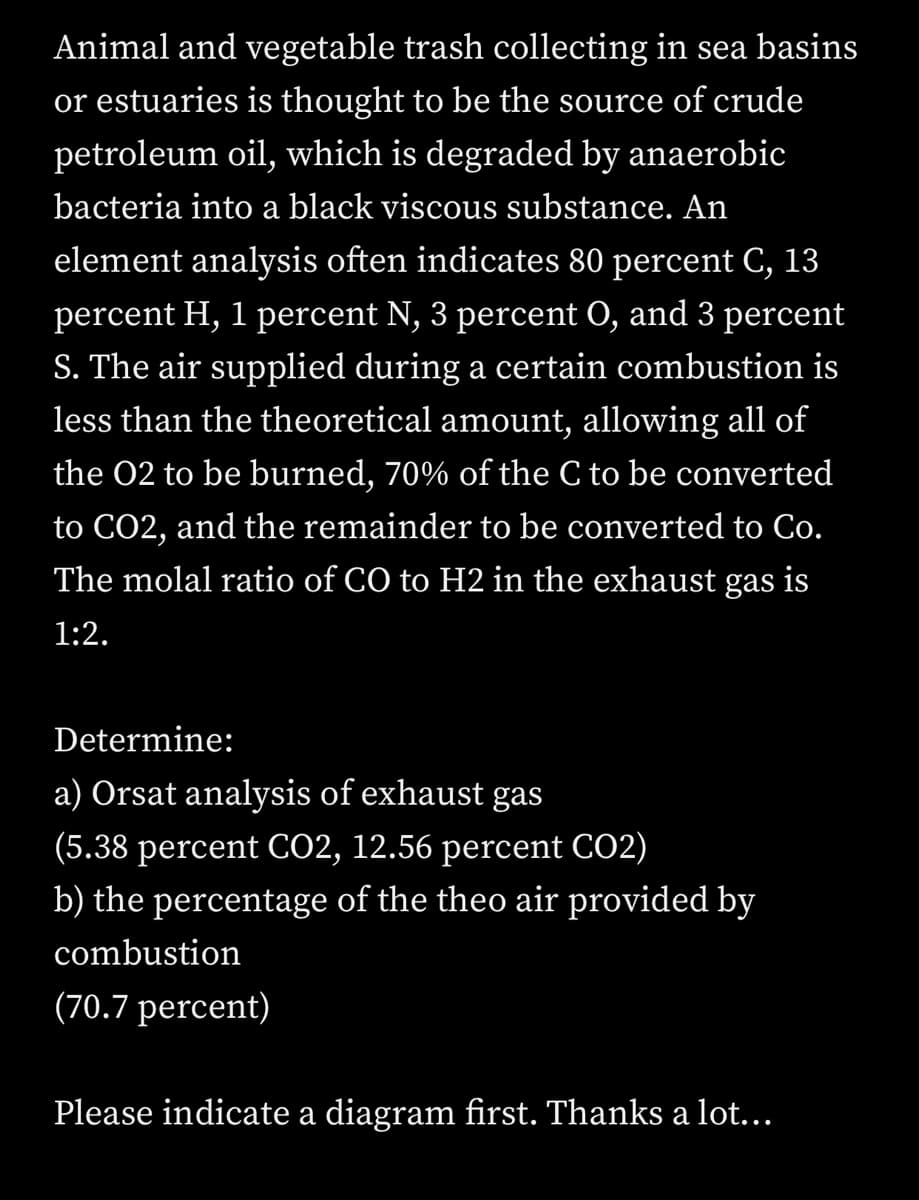Animal and vegetable trash collecting in sea basins or estuaries is thought to be the source of crude petroleum oil, which is degraded by anaerobic bacteria into a black viscous substance. An element analysis often indicates 80 percent C, 13 percent H, 1 percent N, 3 percent O, and 3 percent S. The air supplied during a certain combustion is less than the theoretical amount, allowing all of the 02 to be burned, 70% of the C to be converted to CO2, and the remainder to be converted to Co. The molal ratio of CO to H2 in the exhaust gas is 1:2. Determine: a) Orsat analysis of exhaust gas (5.38 percent CO2, 12.56 percent CO2) b) the percentage of the theo air provided by combustion (70.7 percent)
Animal and vegetable trash collecting in sea basins or estuaries is thought to be the source of crude petroleum oil, which is degraded by anaerobic bacteria into a black viscous substance. An element analysis often indicates 80 percent C, 13 percent H, 1 percent N, 3 percent O, and 3 percent S. The air supplied during a certain combustion is less than the theoretical amount, allowing all of the 02 to be burned, 70% of the C to be converted to CO2, and the remainder to be converted to Co. The molal ratio of CO to H2 in the exhaust gas is 1:2. Determine: a) Orsat analysis of exhaust gas (5.38 percent CO2, 12.56 percent CO2) b) the percentage of the theo air provided by combustion (70.7 percent)
Introduction to Chemical Engineering Thermodynamics
8th Edition
ISBN:9781259696527
Author:J.M. Smith Termodinamica en ingenieria quimica, Hendrick C Van Ness, Michael Abbott, Mark Swihart
Publisher:J.M. Smith Termodinamica en ingenieria quimica, Hendrick C Van Ness, Michael Abbott, Mark Swihart
Chapter1: Introduction
Section: Chapter Questions
Problem 1.1P
Related questions
Question

Transcribed Image Text:Animal and vegetable trash collecting in sea basins
or estuaries is thought to be the source of crude
petroleum oil, which is degraded by anaerobic
bacteria into a black viscous substance. An
element analysis often indicates 80 percent C, 13
percent H, 1 percent N, 3 percent O, and 3 percent
S. The air supplied during a certain combustion is
less than the theoretical amount, allowing all of
the 02 to be burned, 70% of the C to be converted
to CO2, and the remainder to be converted to Co.
The molal ratio of CO to H2 in the exhaust gas is
1:2.
Determine:
a) Orsat analysis of exhaust gas
(5.38 percent CO2, 12.56 percent CO2)
b) the percentage of the theo air provided by
combustion
(70.7 percent)
Please indicate a diagram first. Thanks a lot...
Expert Solution
This question has been solved!
Explore an expertly crafted, step-by-step solution for a thorough understanding of key concepts.
Step by step
Solved in 5 steps with 2 images

Recommended textbooks for you

Introduction to Chemical Engineering Thermodynami…
Chemical Engineering
ISBN:
9781259696527
Author:
J.M. Smith Termodinamica en ingenieria quimica, Hendrick C Van Ness, Michael Abbott, Mark Swihart
Publisher:
McGraw-Hill Education

Elementary Principles of Chemical Processes, Bind…
Chemical Engineering
ISBN:
9781118431221
Author:
Richard M. Felder, Ronald W. Rousseau, Lisa G. Bullard
Publisher:
WILEY

Elements of Chemical Reaction Engineering (5th Ed…
Chemical Engineering
ISBN:
9780133887518
Author:
H. Scott Fogler
Publisher:
Prentice Hall

Introduction to Chemical Engineering Thermodynami…
Chemical Engineering
ISBN:
9781259696527
Author:
J.M. Smith Termodinamica en ingenieria quimica, Hendrick C Van Ness, Michael Abbott, Mark Swihart
Publisher:
McGraw-Hill Education

Elementary Principles of Chemical Processes, Bind…
Chemical Engineering
ISBN:
9781118431221
Author:
Richard M. Felder, Ronald W. Rousseau, Lisa G. Bullard
Publisher:
WILEY

Elements of Chemical Reaction Engineering (5th Ed…
Chemical Engineering
ISBN:
9780133887518
Author:
H. Scott Fogler
Publisher:
Prentice Hall


Industrial Plastics: Theory and Applications
Chemical Engineering
ISBN:
9781285061238
Author:
Lokensgard, Erik
Publisher:
Delmar Cengage Learning

Unit Operations of Chemical Engineering
Chemical Engineering
ISBN:
9780072848236
Author:
Warren McCabe, Julian C. Smith, Peter Harriott
Publisher:
McGraw-Hill Companies, The